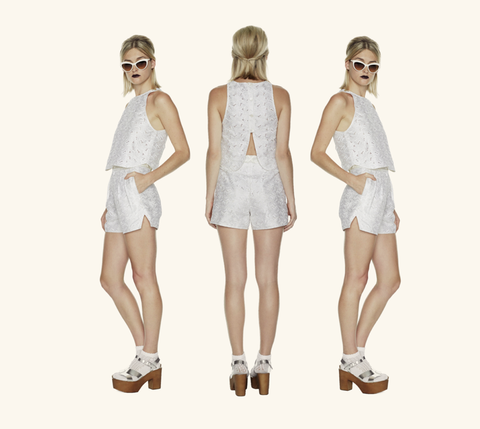Amongst a growing trend, of strong, independent female fashion designers and founders is Samantha Giordano and her company Dolores Haze (Instagram). Her unique take on fashion is no doubt a reflection on her thorough investigation on the dual nature of the modern female experience. In capturing this interesting dynamic, often translated in her eye catching combinations, Sam has elevated her brand to high-end sophistication.
How did the idea for Dolores Haze originate? And how does sustainability fit into the equation?
Samantha Giordano: The concept for Dolores Haze originated over a decade ago after reading Lolita by Vladimir Nabokov. After finishing the novel, I thought, Dolores Haze, Lolita’s full name, is a badass name for a fashion line. She embodies femininity yet is a character infused with darkness. Dolor, the latin root word of Dolores, translates to sorrow, and prophesizes Lolita’s life, in the novel, as a mosaic of melancholic tribulations ultimately leading to her death. Fashion became a means of making an artistic feminist statement, and the namesake continues to provide inspiration. The archetype of the coquettish, precocious, flirty girl is synonymous with Lolita; and this paradigm reveals more about Western society’s sentiment on female sexuality than we realize.
Sustainability was an essential component to the equation. Prior to launching Dolores Haze, I designed for large chain retailers. Many of these companies were, and still are, complacent in fashion’s destruction of the environment. One style of jeans can go on many a plane ride before even reaching the stores leaving a hefty carbon footprint. Denim textiles are shipped to a factory for embroidery, flown to another country for production, shipped to the warehouse, and then, finally to the stores. What I just described doesn’t even account for the harmful impact of non-organic cotton production, pollution from dyes, and unfair labor regulations on garment workers.

In the photo: Samantha Giordano Credit: Dolores Haze
Q: How does Dolores Haze adhere to its values and mission while also staying competitive? Is there a unique business model that you use?
SG: Our brand is defined by our values and mission. We practice what we preach, and provide our customers with transparency. Our business model is predicated on our sustainable and socially responsible values, and we market how our values are intertwined with our products. Our goal is to have people shop with us not just because they like the clothes, but because their values align with our brand’s.
Many consumers aren’t even aware of how deleterious the fashion industry is for the environment or the exploitative practices ingrained and normalized by the industry. Consumers have the right to make informed choices when shopping. Dolores Haze provides consumers with transparency, underscoring our production and sourcing practices. We detail the sustainable components for each style in the product descriptions.
Related article: “DIMMBLÁ: CLEAN FASHION” by OLIVER SPEAKMAN
Q: Are there any unique challenges for sustainability in the fashion industry? How does Dolores Haze overcome these challenges?
SG: One of the biggest challenges in the sustainable fashion is the price point. It’s arduous to compete with fast fashion as their products are heavily marked down. It’s essential that we educate consumers on how we define sustainability and social responsibility. Many people are politically impassioned more than over, and want to make align their values with the products they purchase. Fast fashion companies have usurped terms like feminism, printing like slogans on t-shirts. These companies strip feminism of it’s meaning, because when 80% of garment workers are women, how can a company proclaim “feminism” while neglecting worker welfare? I believe that climbing the hurdle begins with elucidating why sustainability even matters.
Q: What are some of the criteria or things Dolores Haze looks for when sourcing its materials?
SG: Who we source from and the sustainable components of the textile are essential factors when sourcing. We prodimentaly work with small-business immigrant owned businesses, and we always inquire about the backstory of the fabric: where did the vendor source the fabric, do they know where it woven, is the fabric vintage dead-stock, and were organic fibers used? Often we end up working with vintage fabric. This allows us to create limited edition styles in synthetic fabrics without perpetuating the environmentally determinantal processes used to produce synthetic fabric.

Q: What do you think is the future of sustainability, particularly relating to the fashion industry?
SG: The fashion industry will abandon the granola connotation of sustainability, and it will evolve into the norm and define what companies strive to embody (even if they miss the mark.) Margins will no longer be the sole factor defining company practices. There will be a collective commitment shift towards transparency and eco-conscious start-to-finish design. Information will reshape the conversation around fashion, which is what we strive to do. We’ve recently published a blog piece on the underbelly of the cotton industry globally, and why we chose to produce our tote bags with organic cotton. By normalizing transparency fashion trends, such as synthetic fabrics like spandex, will be held accountable to eco and ethical standards.

In the photo: Dolores Haze photo shoots Credit: Dolores Haze
Editors Note: The opinions expressed here by Impakter.com columnists are their own, not those of Impakter.com









